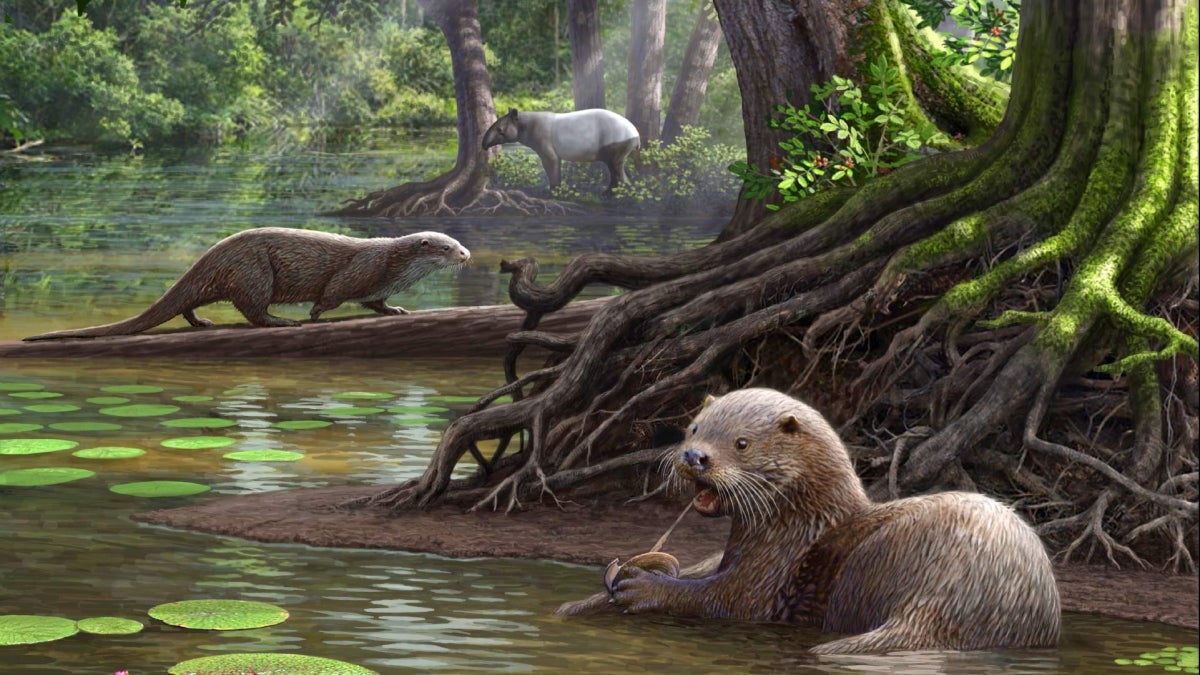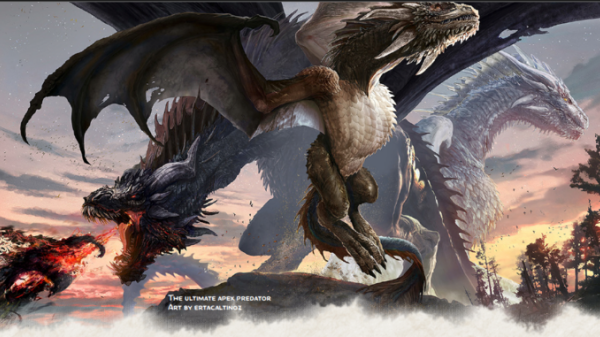Study reveals new details about giant prehistoric otter

Artist reconstruction of Siamogale melilutra and habitat. Image courtesy of Mauricio Antón
In a marshy wetland forest in China 6 million years ago, an otter the size of a wolf appeared to be the top predator. The otter — Siamogale melilutra — weighed nearly 100 pounds, ate mollusks and clams, and lived among water birds, elephants, rhinos, tapirs, deer and beavers.
S. melilutra was a new species discovered in 2017 at a site called Shuitangba in southwestern China by a team of scientists. The team included Denise Su, research scientist at ASU's Institute of Human Origins and associate professor at the School of Human Evolution and Social Change, and Jay Kelley, research affiliate at the Institute of Human Origins.
New findings were recently published in The Anatomical Record with an article titled “Postcranial functional morphology of the large swamp otter Siamogale melilutra (Lutrinae: Mustelidae: Carnivora) from northeastern Yunnan, south-western China."
“When we found the otter, our first question was 'What is it?'" Su said. “The analysis that was undertaken to answer the question of 'what is it' is very different from the analysis we were undertaking to answer the next question: What was it doing, and what was it eating?"
Once researchers understood a little more about what S. melilutra was, they wanted to learn more about how it moved and lived. Otter fossils that were recovered included the craniodental (skull and teeth), a femur, tibia, astragalus (ankle bone), two humeri and two ulnae from different individuals, two radii (one juvenile), and a metacarpal (hand bone), scientists explained.
The skull revealed the animal had teeth with badger-like traits, but what about the rest of the body? To figure out more, they needed to study its bones — especially its legs. That’s where ASU graduate student Brenton Adrian came in.
“I used published measurements from bones belonging to various modern mustelid species to numerically compare proportions of the limb bones, and also measured relevant specimens in museum collections,” Adrian said.
“Different species have limb and bone proportions that reflect their mode of locomotion (e.g., swimming, climbing). By comparing the S. melilutra material with the comparative dataset, we could infer its locomotion based on similarity of bone proportions to modern species.”
Adrian and team were able to determine that S. melilutra’s limbs were similar to both semiaquatic animals (those that live in and around water) and semifossorial animals (those that dig or burrow, like badgers). This suggests it wasn’t a strong swimmer like the cute sea otters we see at the zoo, but probably paddled at the water’s surface. Its body also seems to have been well built for digging or searching along riverbanks.
Because of the well-preserved femur bone, the team was able to analyze the grooves and pits of that bone, which gave them clues about muscle attachment and locomotion. The adaptations Adrian found on the femur indicated there was a lot of hip stabilization that would be helpful for digging.
“Essentially, what we have is a not terribly specialized swimmer but with some digging adaptations thrown into the mix,” Adrian said. “There is a modern otter that is very similar to S. melilutra — clawless otters in Africa of the genus Aonyx. They don’t eat fish primarily; they eat crabs and mollusks and other invertebrates. They basically dig into these muddy riverbanks and pull out all the clams and huge earthworms.”
The researchers said S. melilutra was the largest carnivore known so far from Shuitangba. At other sites in China, from the same time period, lots of hyenas and large cats were found, but not at Shuitangba.
What animals of the past can teach us
So, why should we care about an otter that lived 6 million years ago?
“We are in a time of climate instability,” Su said. “We have been pretty lucky so far as a species; we’ve really been living in the last 10,000 years in a period of extraordinary stability.”
“Looking at animals and ecosystems from times of transition allows us to understand how ecosystems respond to large-scale changes. And that can better equip us, I think, for understanding what's going on today, how the plants and animals today might also respond and help us plan better for our future.”
Su and Adrian talk more about S. melilutra, its habitat, bones and more in the video below.
More Science and technology

Your crash course on quantum science
Confused by quantum science? You’re in good company — even Einstein thought it was too weird to be true.But since his time, experiments have shown that quantum science is, indeed, both weird and true…

ASU researchers blend biology, fantasy in world-building guidebook
Evolution may be the ultimate novelist.Through genes, generations and different environments, it spins characters, conflicts and adaptations.For gamers, fantasy writers and other creators of…

Keys, clues and crypto: How ASU researchers are building smarter tech
The cybercrooks who haunt the digital shadows can use cryptocurrency to move fortunes under the radar, with no strings to hold them back.For those looking to dodge detection, crypto isn’t a curiosity…
